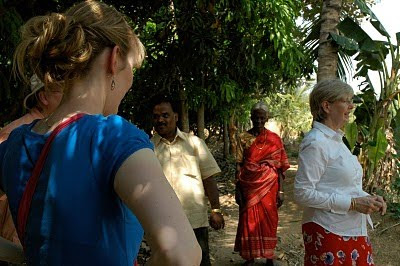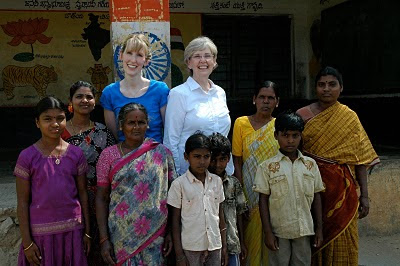
I'm embarrassed to admit it but if you'd asked me last month what rural life in India was like I probably would have resurrected a mental picture straight from Indiana Jones and the Temple of Doom. Starving villagers, emaciated children, dry and dusty landscapes with hovels scattered here and there.

Which is why I was so curious (and rather nervous) to see Sampath's village. He's my parents' driver and while he lives in Bangalore his "native place" (as the Indians say) is the village of Yaramanaguntulu, an hour and a half outside the city where he goes whenever he can. After driving to the coast on Friday and spending the night in Chennai we headed back to Bangalore on Saturday, taking a slight detour so we could visit Yaramanaguntulu and meet his family. It took me about eighteen times of having Sampath repeat the name before I could say it properly.

It really was an honor, my parents think so much of Sampath so to be able to finally meet his family was a treat and I was thrilled that it happened while we were there and it was nothing like my silly Hollywood misconceptions.

While the city can be dirty--trash pretty much everywhere--and the road to Pondicherry was in places lined with sad little huts as a picture of poverty, the village was completely beautiful. Imagine a small town in America with farmhouses and fields of crops stretching out to the horizon past the back porch and cows grazing in the shade; a few dogs here and there and maybe the corn half-way grown. Now pretend it's in India.

The houses were small and many were made of local red bricks covered in plaster then painted in glorious blues and greens and pinks with thatched roofs but the similarities of rural life in India and rural life in America were more than the differences. Sampath has about eight acres where they have mango trees, chili fields and a certain fruit whose name suddenly escapes me.

The yards were clean and the porches swept where chili peppers and tamarind pods were drying in the sun after the recent harvest. They've had a drought for the last two years--the monsoons haven't been as generous--and while water is scarce and drinking water is trucked in by the government the family has a 600 foot well that is powered by the government for their irrigation and household use.

It felt homey and comfortable with the smell of agriculture and livestock blowing around me on the gentle breeze and the chickens peeking out of the shade to go and scratch for a meal and my Dad kept saying how he now understood why Sampath wanted to leave city life and go back to the country to stay on his farm with his children.
Here's a picture of my mom and me with some of his female relations, we're--uh--the ones in the middle. On the way back to the main road we passed a tiny store where some of his friends and family were gathered and when we passed by the woman on the far right came out to meet us. Her daughter, the one in purple on the far left, was nervous but her mother kept smiling and insisting she come forward to shake hands. The woman next to my mother kept gesturing to us and letting us know that she thought we were enormously tall.

While the country life looked idyllic and quaint with all the charms you'd want from the Indian version of the Heartland it also brought us to see the grim reality of Indian life: death. I was told that only very recently has the life expectancy been raised to 60 and while children and teenagers often look much younger than their true ages once adulthood hits you can see how the differences in nutrition and health care have taken their toll.

Sampath is younger than I am but his health is much worse and his mother, who couldn't have been 70, looked nearly one hundred. She was so kind and sweet and welcoming to us but you could see how life had taken away her years and her teeth and her children. When she approached us at first to take our hands in hers in greeting her eyes were red and teary. Sampath's brother who was mentally disabled had developed what they now think must have been stomach cancer but because of the lack of health care and his disabilities they didn't realize it until it was too late and he died two weeks ago. The poor woman was obviously still in mourning for her son and I couldn't help think of all I take for granted.
Sampath says that to live in Bangalore it costs about 10,000 rupees per month (lower middle class) but in his village he can be comfortable on 1,000. Right now there are approximately 50 rupees to the dollar which translates into roughly $200 and $20. No wonder he'd like to go back--but the city has the wages so he stays to work until he has enough to retire and build a house for himself behind his mother's home and stay in the shade sipping mango juice and looking out over his orchards for the rest of his years.
Sounds pretty good to me.
Sponsored by Sorella Jewelry Studio for fine personalized jewelry.

8 comments:
I'm not commenting much while you're in India, Michelle, but I'm inhaling every post. It's all fascinating and thought-provoking and enriching. Thank you for taking the time to share your experiences.
Now I have to go get some frozen mango chunks out of the freezer. I have a craving.
great to read the words of a westerner on Indian rural scene...Indiana Jones depicted a grossly flawed picture:)
The colors in that village are so inspiring - that green wall! The purple saris!
I feel like whatever I comment will be inadequate, I'm moved that much!
What a wonderful, eye-opening, life-altering experience!
Michelle,
Just makes you truly thankful for everything we have here at home and for all that we take for granted everyday.
Thank you for sharing all of this with us and taking us along in your journey!
Love and Hugs ~ Kat
FIrst of all, you are really tall! Ha! That pic cracks me up!
I, too, appreciated the difference between village life and city life in Mauritania. There's a simplicity and dignity there that it seems big cities miss, and while there's still poverty, there isn't squalor, and there just seems more to go round.
And I could never guess Mauritanian's ages. Part of it is women marry earlier and are often mothers very young, part of it is nutrition and health, and part of it sun exposure.
thanks for the inside scoop into your new friend's life... sigh...
Oh, and I love that first colorful doorway!! it really is bright and cheerful... now to pray for S's family... sigh.. again...
Post a Comment